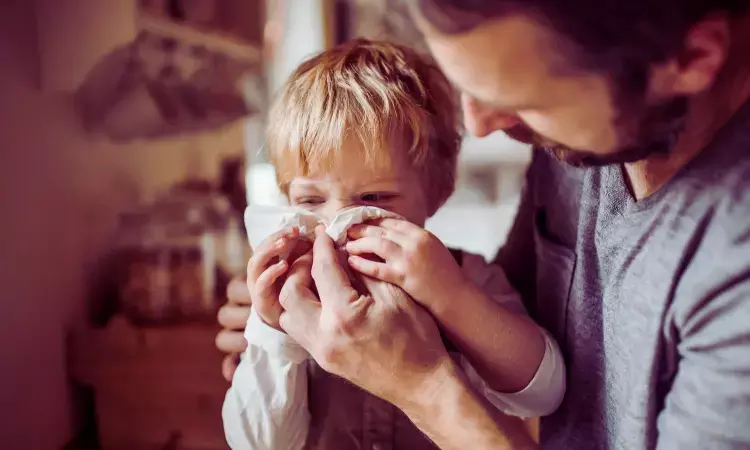- Home
- Medical news & Guidelines
- Anesthesiology
- Cardiology and CTVS
- Critical Care
- Dentistry
- Dermatology
- Diabetes and Endocrinology
- ENT
- Gastroenterology
- Medicine
- Nephrology
- Neurology
- Obstretics-Gynaecology
- Oncology
- Ophthalmology
- Orthopaedics
- Pediatrics-Neonatology
- Psychiatry
- Pulmonology
- Radiology
- Surgery
- Urology
- Laboratory Medicine
- Diet
- Nursing
- Paramedical
- Physiotherapy
- Health news
- Fact Check
- Bone Health Fact Check
- Brain Health Fact Check
- Cancer Related Fact Check
- Child Care Fact Check
- Dental and oral health fact check
- Diabetes and metabolic health fact check
- Diet and Nutrition Fact Check
- Eye and ENT Care Fact Check
- Fitness fact check
- Gut health fact check
- Heart health fact check
- Kidney health fact check
- Medical education fact check
- Men's health fact check
- Respiratory fact check
- Skin and hair care fact check
- Vaccine and Immunization fact check
- Women's health fact check
- AYUSH
- State News
- Andaman and Nicobar Islands
- Andhra Pradesh
- Arunachal Pradesh
- Assam
- Bihar
- Chandigarh
- Chattisgarh
- Dadra and Nagar Haveli
- Daman and Diu
- Delhi
- Goa
- Gujarat
- Haryana
- Himachal Pradesh
- Jammu & Kashmir
- Jharkhand
- Karnataka
- Kerala
- Ladakh
- Lakshadweep
- Madhya Pradesh
- Maharashtra
- Manipur
- Meghalaya
- Mizoram
- Nagaland
- Odisha
- Puducherry
- Punjab
- Rajasthan
- Sikkim
- Tamil Nadu
- Telangana
- Tripura
- Uttar Pradesh
- Uttrakhand
- West Bengal
- Medical Education
- Industry
Young Children Found to Carry the Most viruses during flu and cold season, Study Reveals

A new study published in the journal of Pediatrics found that pre-kindergarten and elementary school children had the highest rates of virus detection and acute respiratory illnesses (ARIs) when compared to older students and staff, confirming that younger students harbor the most germs during flu and cold season.
Schools are well-known spots for infectious disease transmission, yet, detailed data on how often respiratory viruses spread among students and staff have been limited. The Knowledge of Infectious Diseases in Schools (School KIDS) study was conducted in a large Kansas City public school district with over 20,000 students to fill that gap.
From November 2022 to May 2023, a total of 816 participants (590 students and 226 staff members) took part in the study. The participants self-collected nasal swabs and reported respiratory symptoms weekly. This research received 5,981 specimens and 5,198 symptom surveys, which allows for an in-depth look at how respiratory viruses circulate across different grade levels.
The study found that 85.5% of participants had at least one virus detected, while 80.4% reported at least one episode of acute respiratory illness during the study period. When adjusted for school attendance days, the rates revealed that the youngest children had the highest levels of infection.
Pre-kindergarten and elementary school students showed the greatest virus detection rates, with 1.46 and 1.51 cases per 100 enrollment days, respectively. These groups were followed by middle school students (1.19), high school students (0.90), and staff members (0.87).
However, when looking at the rates of actual illness episodes the results were slightly different. Pre-kindergarten students and school staff had the highest ARI rates, at 1.66 and 1.45 per 100 enrollment days, respectively. Elementary and middle school students followed closely, while high school students showed the lowest rate at 0.76.
This research suggest that younger children’s developing immune systems and close-contact classroom environments may contribute to higher transmission rates. For staff, frequent exposure to multiple classrooms and age groups could explain their elevated illness rates.Overall, these findings suggest that younger students face the highest risk of respiratory virus infections, while both pre-K children and staff experience the most frequent illness episodes which highlights the need for improved prevention measures in early education environments.
Source:
Goldman, J. L., Lee, B. R., Almendares, O. M., Kirking, H. L., Derado, G., Banerjee, D., Sasidharan, A., Porter, J., Tilsworth, S., Selvarangan, R., & Schuster, J. E. (2025). Respiratory virus detection and acute respiratory illness rates in students and staff in schools. Pediatrics, 156(4). https://doi.org/10.1542/peds.2025-070886
Neuroscience Masters graduate
Jacinthlyn Sylvia, a Neuroscience Master's graduate from Chennai has worked extensively in deciphering the neurobiology of cognition and motor control in aging. She also has spread-out exposure to Neurosurgery from her Bachelor’s. She is currently involved in active Neuro-Oncology research. She is an upcoming neuroscientist with a fiery passion for writing. Her news cover at Medical Dialogues feature recent discoveries and updates from the healthcare and biomedical research fields. She can be reached at editorial@medicaldialogues.in
Dr Kamal Kant Kohli-MBBS, DTCD- a chest specialist with more than 30 years of practice and a flair for writing clinical articles, Dr Kamal Kant Kohli joined Medical Dialogues as a Chief Editor of Medical News. Besides writing articles, as an editor, he proofreads and verifies all the medical content published on Medical Dialogues including those coming from journals, studies,medical conferences,guidelines etc. Email: drkohli@medicaldialogues.in. Contact no. 011-43720751


